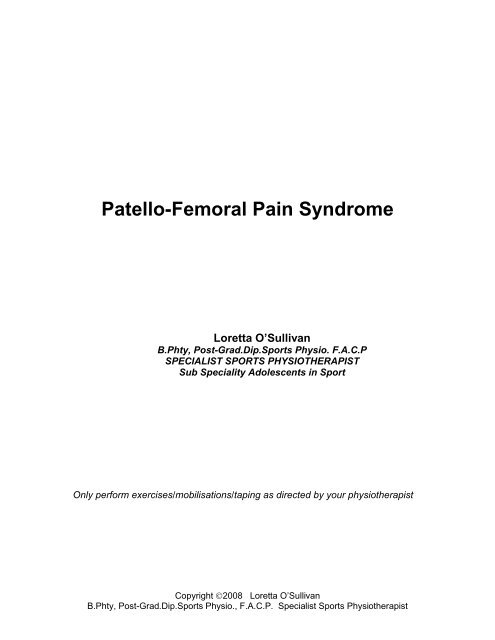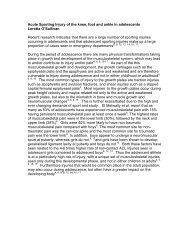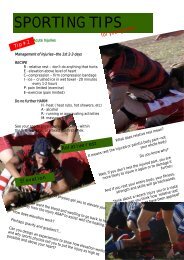Patello-Femoral Pain Syndrome - Twelve9Teen Sports Physiotherapy
Patello-Femoral Pain Syndrome - Twelve9Teen Sports Physiotherapy
Patello-Femoral Pain Syndrome - Twelve9Teen Sports Physiotherapy
- No tags were found...
Create successful ePaper yourself
Turn your PDF publications into a flip-book with our unique Google optimized e-Paper software.
<strong>Patello</strong>-<strong>Femoral</strong> <strong>Pain</strong> <strong>Syndrome</strong>Loretta O’SullivanB.Phty, Post-Grad.Dip.<strong>Sports</strong> Physio. F.A.C.PSPECIALIST SPORTS PHYSIOTHERAPISTSub Speciality Adolescents in SportOnly perform exercises/mobilisations/taping as directed by your physiotherapistCopyright 2008 Loretta O’SullivanB.Phty, Post-Grad.Dip.<strong>Sports</strong> Physio., F.A.C.P. Specialist <strong>Sports</strong> Physiotherapist
Against the Wall• Standing side on to the wall• Stand on the leg which is further from the wall – leg turned outslightly, make sure knee is straight – not locked, not bent (1mmoff locked)• Leg closer to the wall – bend knee to 90 o , thigh in line with body(not in front) and gently push your knee into the wall. No otherpart of your body should be touching the wall.• Make sure you are standing tall and weight is on your outsideleg• Place your outside hand on your butt (hand in back pocket)• Try to turn the knee of the outside leg, outwards (using yourbutt), without moving your pelvis or trunk, hold.Progressions-take weight off inside knee (one leg stance)-add inner range VMO control, very small knee bend- as above on one leg- add movement to unsupported leg-add speed/load to this movementTibialis Posterior/Peroneus LongusSetting• In standing, try to make an arch in your foot.• Keep the base of your big toe on the ground and your toes relaxed.• You shouldn’t see any muscle activity on the front of your ankle.Progressions• In step stance, transfer your weight to the front and back feetwhilst maintaining good foot posture, feel yourself push throughthe base of your big toe• Maintain this position as you come up onto your toes• Add into other drills/exercises in standingSTANDING DRILLS(ALL DRILLS)• Stand in front of mirror• Set TA & IO• Pelvis level, using gluts (fingers to hip bones to monitor)• Legs turned out slightly• Knees slightly vent, using VMO• Knee caps pointed over 2 nd /3 rd toes, using gluts• Arches in feet and base of big toe down, using tib post/peroneuslongusCopyright 2008 Loretta O’SullivanB.Phty, Post-Grad.Dip.<strong>Sports</strong> Physio., F.A.C.P. Specialist <strong>Sports</strong> Physiotherapist
Squats –• Keep back straight.• Shins perpendicular to the ground and knees turned out.• Bend at hips and knees• Stick butt out and reach arms forward to balance.• Don’t arch or round your back, keep chest open• Slowly squat down and as you come up, push through yourheels and squeeze your buttLunges –• Take a big step.• Keep back straight.• Front shin perpendicular to the ground.• Knees turned out and pelvis level.• Lower back knee and slowly raise pushing through your frontheel and using your butt on your front leg• You should be on your toe on the back foot (balance only)• Your weight should be through your front heelOne leg squat –• Stand on one leg• Keep back straight and shin perpendicular to ground• Bend at hip and knee, sticking your butt out and reachforward with arms• Slowly lower and raise, ensuring perfect form.Stability jumps –• Stand on injured leg• Jump forward by performing a one leg squat as above• Land on the uninjured leg, cushioning by bending knee andankle• Keep your pelvis level, knee cap pointed over your 2 nd /3 rdtoe as you land (as in one leg squat)Progressions- Jump from uninjured to land on injured- Jump from injured to land on injured- Increase distance of jump/hopCopyright 2008 Loretta O’SullivanB.Phty, Post-Grad.Dip.<strong>Sports</strong> Physio., F.A.C.P. Specialist <strong>Sports</strong> Physiotherapist
Sub-Talar Joint Mobilisations• Sitting on a chair with legs crossed so your ankle rests on your knee• Hold your ankle with your hand of the same side, rest your forearm alongyour shin so your elbow is resting on the knee of the crossed leg, tostabilise the leg• With your other hand, grasp the heel of the crossed leg, so the heel ofyour hand is on the top surface and your fingers are wrapped around theunder surface• Lock the elbow of that arm• Using your body weight, pushing from your shoulder, push your heel downand around• Hold this mobilisation, then gently release slightly before mobilising againTaping<strong>Patello</strong>-<strong>Femoral</strong> Tape• Make sure your knee cap is relaxed and will move around.• Your skin should be clean and dry. Shaven 24hours prior.• Tape can be left on for five days, you get more irritation from pulling thetape off, than leaving it on.• Soak the tape in oil or nail polish remover, before removing. Lift off gently,holding the skin down.• If you get any itchiness or burning, take the tape off.• If the tape makes your pain worse, take the tape off• The tape can get wet, dry it with a hairdryer or pat it dry with a towel.• Use ‘Fixomil’ underneath and ‘Leuko P’ on top.• If you are allergic to tape (zinc oxide), use only ‘Fixomil’.1. To start• Place Fixomil over the knee cap from the outside to the inside of the knee.• The tape should go a fair way down the inside of your knee.• The ‘Fixomil’ should go directly over the knee cap.• No pressure is applied to the ‘Fixomil’.2. AP Tilt• When applying the ‘Fixomil’, place it over the top half of the kneecap.• Continue with the remainder of the taping, staying to the top half of theknee cap.3. Lateral Tilt• Place ‘Leuko P’ tape in the centre of the knee cap, lift the tissues on theinside of your knee up and pull the tape down to the inside of knee. Repeat.Copyright 2008 Loretta O’SullivanB.Phty, Post-Grad.Dip.<strong>Sports</strong> Physio., F.A.C.P. Specialist <strong>Sports</strong> Physiotherapist
4. Lateral Glide• Place ‘Leuko P’ tape on the outside edge of the knee cap and with yourthumbs, push the knee cap inwards.• Use your fingers to gather up the tissues on the inside of your knee cap.• Pull the tape across to the inside of your knee to hold this. Repeat.5. Infra Patella Unloading Tape• Make a ‘V’ with the ‘Fixomil’ around the fatty/puffy part of the knee, meetingon the shinbone.• With the ‘Leuko P’ tape, start on the shinbone and pull up and out, pullingup some of the skin with your fingers so you get some puckering.• Repeat on the other side. Do two each sideSubtalar Joint Tape• In the subtalar joint mobilisation position• Place a piece of Leuko Premium Plus, diagonally across your heel• Apply pressure like in the mobilisation• Wrap the ends of the tape around your foot, finishing just under the anklebone on the outside of your foot• The ends of the tape should meet each other• RepeatNavicular Lift Tape• Sitting with your ankle resting on your thigh of the opposite knee• Starting on the top of the outside of your foot• Gently wrap the tape around your foot• As you reach your arch, apply pressure as if to lift this area up• Continue to wrap tape until you reach where you started• RepeatCopyright 2008 Loretta O’SullivanB.Phty, Post-Grad.Dip.<strong>Sports</strong> Physio., F.A.C.P. Specialist <strong>Sports</strong> Physiotherapist





